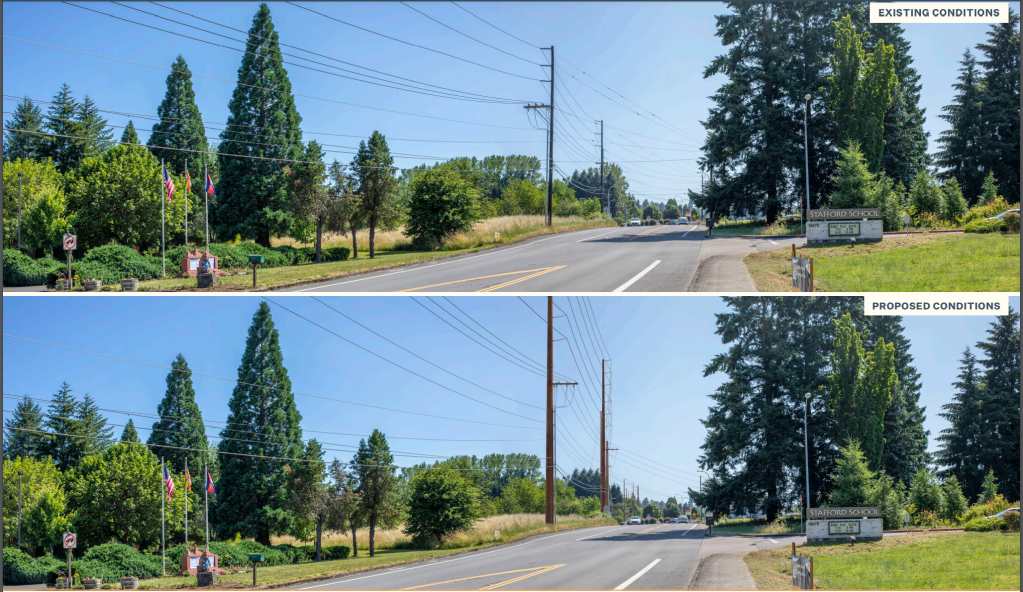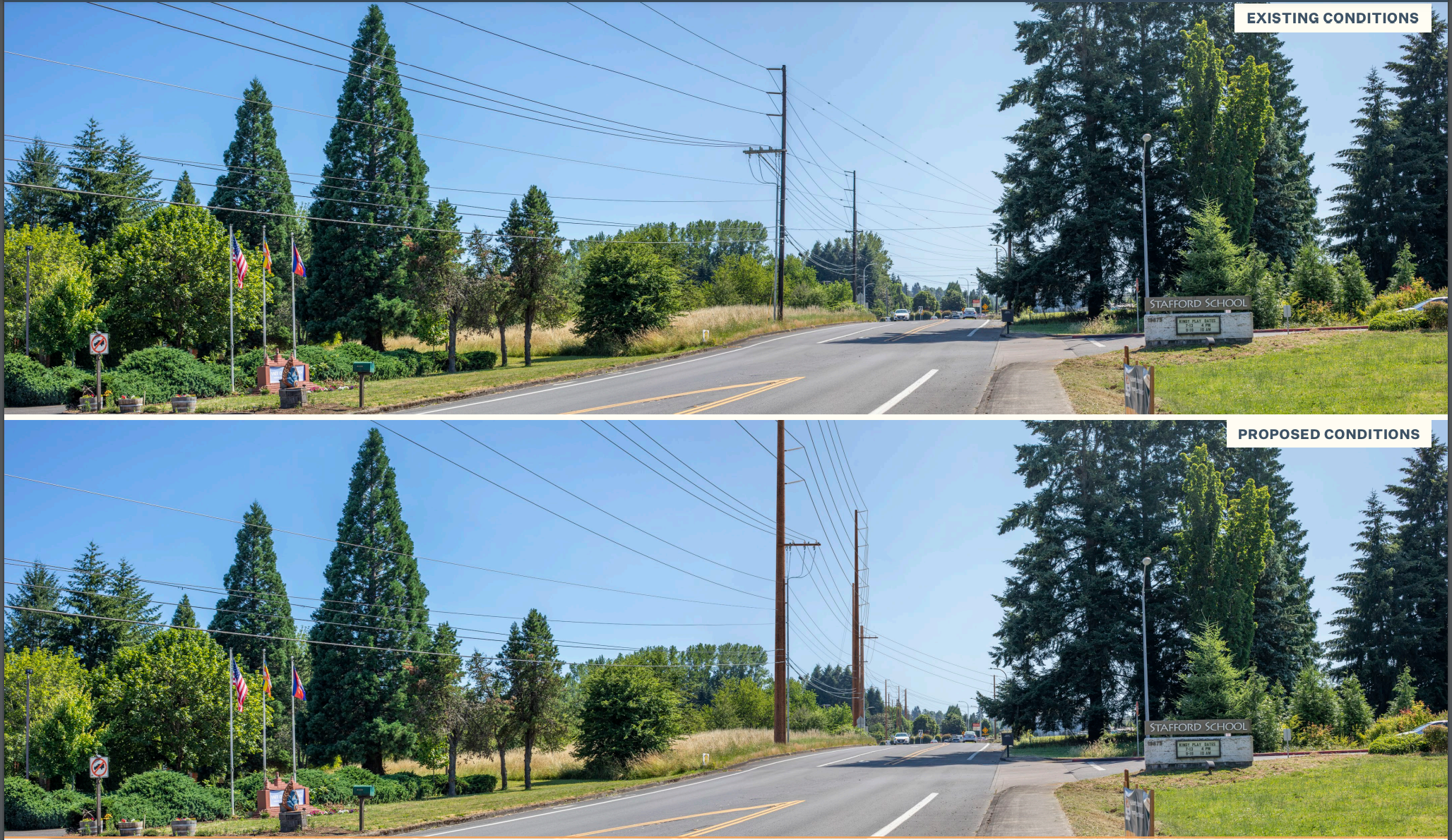Court says Clackamas County must reconsider Portland General Electric’s Stafford transmission line application
Published 2:32 pm Monday, January 27, 2025

- A simulation shows what one section of Stafford Road could look like after completion of upgrades to power poles and transmission lines related to the Tonquin Project. (Submitted by Portland General Electric)
Portland General Electric received a favorable ruling last week in its push to upgrade transmission lines along Stafford Road — despite the concerns of neighbors.
In a ruling released Thursday, Jan. 23, the Oregon Land Use Board of Appeals ordered that Clackamas County must reconsider a land use application put forward by PGE to build the lines between the Rosemont and Wilsonville substations along Stafford Road.
The appeals board determined that the county’s planning director “misconstrued the local code” when deciding to void PGE’s application for a land use permit related to the project in September. Therefore the county will have to consider PGE’s application on its merits. Save Stafford Road — an organization of Stafford residents that has fought the utility company’s project for over a year — is an intervenor in the case.
In its rejection last year, the county determined that PGE did not meet a requirement that it obtain the requisite authorization from property owners affected by the project, which meant it was not eligible to initiate the application.
The appeals board sided with PGE in determining that such rules do not preclude PGE from initiating a land use application under state law because it is a public utility company.
“Under the county’s interpretation, a public utility would be required to condemn (and pay compensation for) private property prior to determining whether it can obtain necessary land use approval to develop the use on that property. In addition, as petitioner points out, the county’s interpretation essentially allows individuals or entities who oppose plans for public utility development on or over property they own in the county to effectively obstruct or delay a county determination of whether the development satisfies county land use standards,” the LUBA decision reads.
Clackamas County declined to comment on the LUBA ruling.
“PGE appreciates the Land Use Board of Appeal’s decision that ultimately, PGE had appropriately initiated an alteration of non-conforming use application and the County’s code could not be interpreted to prohibit that. PGE will work with the County to determine next steps,” PGE spokesperson Andrea Platt said in an email.
Members of Save Stafford Road believe that PGE is circumventing rules that should prevent the project from moving forward.
“If this LUBA ruling is allowed to stand, it will set a dangerous precedent of allowing PGE to condemn private property at will, without any input from the property owner,” Kelly Bartholomew, a Stafford resident and member of Save Stafford Road said in a written statement. She added that she believes if PGE cannot meet Clackamas County’s requirements for a permit, then it should alter the project.
Ed Wagner, another Stafford resident who is involved with Save Stafford Road, said in a written statement residents are concerned about what would happen if PGE is able to condemn and take possession of property before receiving a land use permit.
Background
The appeals board’s decision is the latest in a complex web of legal proceedings related to PGE’s efforts to upgrade 7.4 miles of transmission lines and power poles between the Rosemont and Wilsonville substations along Stafford Road. Residents on the road have long opposed the project out of concern that it could lead to increased fire and health risks, and a decline in property values.
The upgrades are part of PGE’s Tonquin Project, which involves building a new substation in the southern portion of the utility company’s service area and upgrading 11 total miles of transmission lines across Tualatin, Sherwood, the Stafford area, Wilsonville and unincorporated Clackamas County.
In previous interviews, Platt said the project will modernize the power grid and allow for redundancy to help accommodate future growth and reduce power outages. Redundancy allows for alternative routes for power to travel, which Platt previously compared to vehicles being able to travel different roads if one road is blocked.
According to legal documents, the upgrades along Stafford Road include replacing 137 power poles — of which 124 are within public right of way, seven are on tax lots owned by PGE and six are located on private property. Easements for power lines or vegetation maintenance are needed on 25 properties.
A separate proceeding with the Public Utilities Commission
Last year PGE applied to receive a Certificate of Public Convenience and Necessity from the Oregon Public Utility Commission that would allow the utility company to condemn property for the project. A decision on the certificate is expected in the coming months.
While PGE received a waiver to apply for the certificate without an approved land use permit from Clackamas County — which it ordinarily would have needed to submit the application — a July 16 letter by a lawyer representing PGE to the Public Utility Commission stated that “the commission made clear at its public meeting that it would not issue a CPCN until that permit had been secured and offered as evidence into the case.”
To move forward with the proceeding in the absence of the permit, the utility company sought and received a Land Use Compatibility Statement from Clackamas County, issued on Aug. 23.
“A LUCS is not a land use decision but rather a statement indicating whether a project would or would not be compatible with (the county’s rules) and comprehensive plan if certain permits are obtained in the future,” Clackamas County Public Information Officer Scott Anderson said in an email.
Save Stafford Road appealed the validity of the compatibility statement to LUBA, which the appeals board dismissed in December. The board said the compatibility statement is not a land use decision and therefore it did not have authority to hear the case.
The project along Stafford Road requires upgrades across land zoned Exclusive Farm Use District and Rural Residential Farm Forest 5-Acre District, according to the county’s letter issuing the compatibility statement. Two paths forward for the project were identified for each zone, which require permits and approval from the county.
In an email before the appeals board ruling, Anderson wrote that the county would be able to consider PGE’s application if the utility company successfully receives the certificate from the Public Utilities Commission and can use that certificate to meet the county’s requirements for an “owner” of the property.
“Outside of the land use process, it’s difficult to say whether or not the application would be or could be approved,” Anderson said in the email. “The applicant will need to demonstrate compliance with applicable land use requirements which would be reviewed by staff through the land use process.”
Anderson added in the email that the land use process for the required permit gives opportunity for public comments and participation.
Save Stafford Road fought against the project in the Public Utilities Commission proceeding until Bartholomew said the organization ran out of funding last October and was forced to withdraw from the proceeding. Bartholomew said the organization had spent over $160,000 in funds raised by homeowners for legal fees and independent expert reviews at that time.
Shortly after, Bartholomew petitioned to intervene in the proceeding as a private resident.
“At that point we had put in so much effort into the process that I didn’t want to lose that entire effort,” Bartholomew said in an interview. She emphasized that in the utility commission proceeding, she does not represent Save Stafford Road “in any way” and just represents “our private community.”





